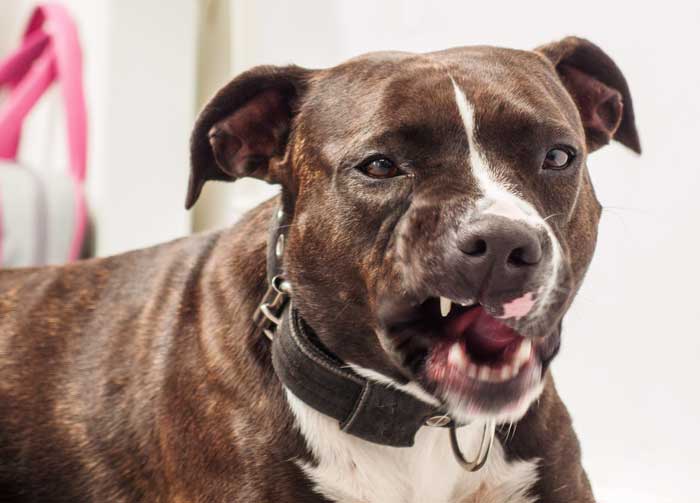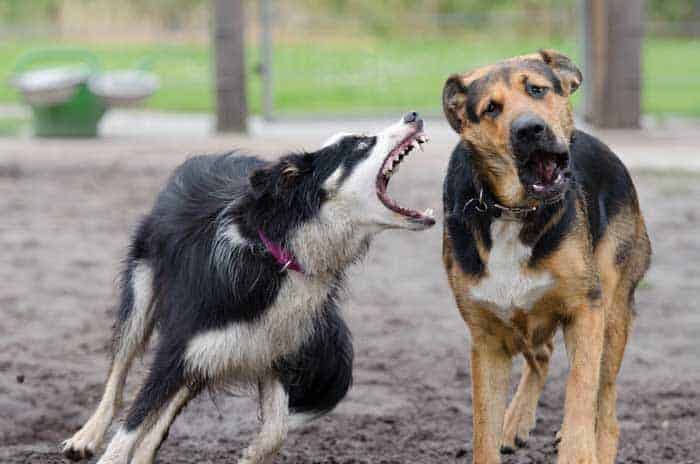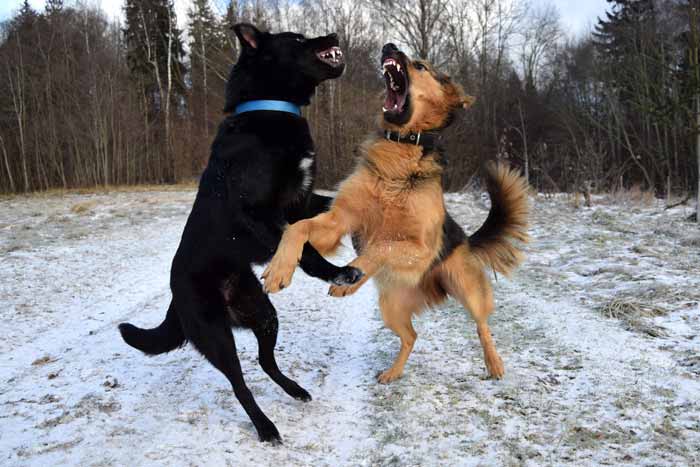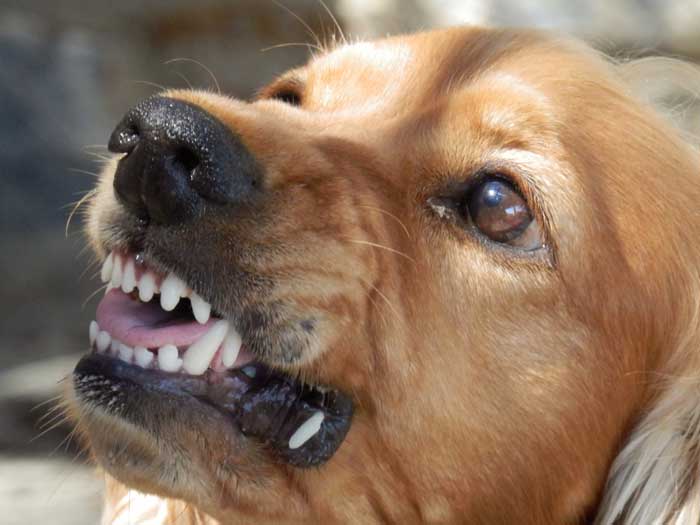Aggression in dogs is not really something that anyone wants to see in their pet. Not only is it not the most charming quality of your dog, but it is also one of those behavior problems that can get your dog into a lot of trouble.
If your dog has aggressive behavior toward some of the dogs that roam around your neighborhood, there’s a good chance that your dog will come home with a few extra claws marks one day.
In some cases, aggressive behavior can become a more prominent trait over time. If this is not stopped early on, it can result in your dog display aggression toward your family members, and even you.
This is something that nobody wants to have happened. However, before you can begin to prevent aggression in your dog, you are first going to want to understand what exactly is causing your dog to become aggressive.
For this reason it’s essential to ask ourselves “why is my dog becoming more aggressive?”
Being able to know what causes aggression in dogs is the first step to prevent aggression from increasing over time and eventually taking over your dog.
Thankfully, canine aggression is a relatively well-understood area which means that it will be fairly easy to get a good understanding of it.
What Causes Aggression in Dogs?

Many different factors go into what makes a dog, or any animal, aggressive. Some dog breeds are hardwired to be aggressive by nature, which is an unfortunate aspect of purebred dogs.
Some other common factors to consider are internal and external influences. Dogs can become more aggressive as a response to the environment, people or other animals.
Likewise, they can become more aggressive because they are in pain due to an injury or health problem and are unable to communicate that discomfort through words.
There are also a few things to consider about your dog. Typically, male dogs who have not been neutered are more prone to display aggression toward other dogs. In extremely simplified terms, you can think of this as testosterone levels running high, and your dog needing an outlet for that.
For this kind of dog, the aggression will occur during puberty, or when the dog is between six and nine months old, and it will end when the dog is more mature, which happens after 18 to 36 months.
Differentiating Playfulness with Aggression

Dog owners who have never owned a dog before might be terrified when their dog starts playing with another dog, as playfulness between dogs often consists of play fights.
Determining whether or not your dog’s aggression is increasing is hard to do when you do not know the difference between a playful fight, or a fight that is bordering on becoming dangerous.
Signs that your dog is being more aggressive than playful include: being very still and rigid, barks and growls that are almost guttural and are meant to threaten, attacking at another dog, pet or person without warning, and so on.
Some harder-to-spot signs of an aggressive dog include growling, snarling, showing the teeth, and “muzzle punches.” These punches are quite literally punches thrown by your dog’s nose.
There are also some signs that are relatively obvious, such as biting and nipping. Nips can sometimes leave no mark, although they can turn into a quick bite that tears the skin.
Real bites can range anywhere from causing a bruise to puncturing the skin, biting repeatedly, and biting and shaking at the same time.
These are all signs that your dog is not actually playing, but is being incredibly aggressive. If your dog is showing these signs, you need to carefully remove him from the area so that you can find a way to calm your dog down.
Types of Dog Aggression, and What Causes Them?

There are several common ways your dog is going to express aggression. These will generally center around the need to guard something or someone, the need to protect himself, or more primal needs.
A Dog Need to Guard Something
If your dog’s aggression is more focused on guarding something, this can make home life difficult.
Whether it is territorial aggression, which focuses on defending a specific territory from friend or foe alike, or resource guarding, a type of possessive aggression which focuses on guarding his food, his favorite toy or other particular objects from anyone who comes too close, it can make you feel as if you have to tiptoe around your dog.
A Dog Need to Protect
Aggression that comes from the need to protect can seem sweet at first, but if it is not handled correctly, it can cause messes quickly. This will usually happen when your dog:
- Feels the need to protect friends or family who are in perceived danger.
- In response to fear when feeling cornered or trapped by something.
- Is reacting to another animal or dog’s aggression through the idea that “the best defense is a good offense.”
A Dog Primal Needs
Aggression that stems from a more primal need can be the hardest to control.
- Aggression to people and pets who are in a “lower status” than the dog.
- The dog is feeling frustrated and has no other way to express that frustration.
- As an improperly directed response toward arousal.
- The dog is in pain.
- A natural predatory instinct.
Stopping your canine friend from being too aggressive can only be done when you understand why your dog is aggressive in the first place.
Sometimes, Dogs Learn From the Owner
Aside from the above reasons why your dog might be aggressive, some dog behavior problems follow the “monkey see, monkey do” mindset.
If an owner asserts his or her dominance as the “alpha” of the household over a smaller, meeker dog, there’s a chance that your dog might do the same when meeting another small, meeker dog.
If you notice that your aggressive dog is following in these patterns, the best thing you can do is cease this behavior as soon as you can.
When your dog realizes that this is not the way the “alpha” of the household acts, there’s a very good chance that your dog will also stop with that type of behavior.
How Can I Prevent Aggression in My Dog?

In some cases, such as when your dog is being aggressive over a specific toy, it might be best to remove that toy from your dog’s access.
Depending on how well your dog responds to this kind of treatment, it might be a possibility that that specific toy never sees the light of day again. It is an unfortunate fact that some dogs simply do not handle some toys well.
If your dog’s aggression comes from a more instinctual need, such as arousal, it might be a good idea to have your dog fixed. It is a well-documented fact that neutered dogs are significantly less aggressive than their unfixed counterparts. The same goes for spaying a dog, although this is more to prevent heat and poorly redirected aggression through that outlet.
If the aggression comes from pain or a medical problem, it might be time for a trip to the vet.
If the aggression is brought on suddenly, this is also a good reason to go to the vet, as there could be something going on in your dog’s brain. This might not be pleasant to think about, but it is something that you are going to have to keep in mind.
Generally, if dog aggression occurs in certain places, it goes without saying that you should avoid those places to avoid the problem.
If it happens to be a neighbor’s house, you might want to consider taking a different route for your daily walks. This applies to leash reactive dogs who do not get along with other dogs in the neighborhood as well.
Aside from these common causes of aggression, it might also be time for you to consider taking your dog to an animal behaviorist or a training course, where your dog can learn how to control his or her aggressive behavior.
What Treatments Are There?
When you are taking your dog somewhere to deal with his aggressive behavior, you have a few things to consider.
Taking your dog to a training course can be stressful for your dog. While the professionals there know how to handle angry, aggressive dogs, nobody really enjoys putting their dog through that kind of stress. However, it might also be one of the only ways for you to have your dog learn how to act.
This is the kind of thing that you, as a dog owner, will need to find the balance between.
You can also take your pet to an animal behaviorist. These behaviorists might not always have the equipment needed to deal with aggressive dogs, although there’s a good chance that someone on the staff will know.
However, this route generally will not take as long, and there are more chances for you to see your dog in the process.
Sometimes, a dog behaviorist will determine that the dog’s aggression comes from fear, stress or anxiety. This is where a veterinarian will come into play.
Some dogs will need medication to help calm down their system forcefully. Some people might not like this idea, but it is also one of the easiest solutions to handling a dog that has become aggressive through poorly redirected stress or anxiety.
Final Thoughts
It is an unfortunate fact that dog aggression is a behavior that cannot always be entirely cured.
Of course, you and your dog can both learn how to manage each other and find new ways to keep that aggression in check, but you should never, ever, believe that the aggression is completely gone.
This means that you should always keep a note that your dog has aggressive tendencies in the back of your mind, so that in a worst-case scenario, you can be as prepared as possible.

